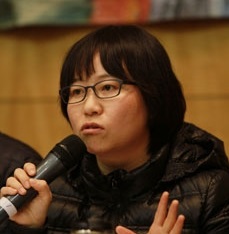
‘Women with Disabilities Empathy (WDM)’ criticizes the attributing the body and the experience of women with disabilities to just ‘disability’. WDM carries active movement on disability and gender intersecting, independent issues. It opposes the inequality and discrimination the disabled women experience and proceeds movements on various themes such as body, sexuality, independence and violence of disabled women. Proclaiming with solidarity with the minority, it works for the society of human rights and value of anti-discrimination.
WDM, which marked the 20th anniversary in 2018, has been agonizing over the slogan by adjusting the meaning of activities. ‘A prohibition on discrimination’ was missed on the national political agenda there is no specific plans and budgets on disability rating system. Calling people with disabilities ‘impossible’ with the disparaging eyes, and now I wanted to recreate the meaning of ‘disability’. Invincible politics of disabilities, which is at odds with the times, means that WDM will create own destiny by refusing to entrust others. At the same time, ‘disability’ in Korean means that it is difficult to save itself, not a condition in which the body has lost its function. Those who are not fully and cannot be saved by themselves are suspicious of normality. They rely on and support each other to ask that they cannot save themselves is social responsibility or not. WDM challenges to twist and reconstruct the meaning of ‘Not’, which negatively implicates a ban on social minorities. It was a declaration to face generations and to write politics of disability through resistance and imagination, not through treatment and overcoming speech.
Disabled women become abnormal due to body differences. They encounter other bodies that are forced as normal form. Social abnormalities in other bodies have led to a variety of discrimination. Unhealthy, ill or damaged body, old body, female/non-male body, transgender body, fat body... All are abnormal bodies. So WDM notes that transgender has the meaning of the diagnosis of ‘sexually challenged’ and that HIV/AIDS-infected people have a life of disability. And that social recognition depends on the ‘cause’ of disability and disease, as well as on the degree of damage. Based on the restrooms that are gender-separated in black and white, the sexual minority experiences discomfort and discrimination. They criticize the sexually dichotomy space, and they sympathize with the need for a gender-neutral toilet that anyone can access without discrimination. Creating a new point of social movement through meetings involves tension and caution, but it is fluttering.
The identity of the ‘disabled’ and ‘female’ becomes a vague and comprehensive concept when they reject to subject to disability ratings. There are certain concepts in the legal and institutional categories, but they varied from time to time. Korea separates the physically handicapped people based on medical standards and provides welfare services by disability rating system. Limited choice is forced within the nation-provided services. Korea enacted the ‘Rehabilitation for the Disabled’ in 1989. The disability rating system was implemented to grade the degree of damage on a medical basis. It is a method of legal exclusion, such as a policy of accommodating disabled residential facilities. President Moon Jae-in promised abolition of the disability rating system but actual budget and policy is absent.
“If there are people who need some kind or other amount of support compared to what is given to a typical citizen, they are considered socially dependent,” Susan Wendell said in her book, The Rejected Body. The representative one is the disabled. The society’s strong rule of ‘unable body’ for the disabled creates an image of the disabled as being dependent. So it makes them think that they are living on free rides without participating in economic activities. Some continues to reinforce the social perception that the stigma of being unproductive is ‘the dependence on welfare’. “You’re better off, so stop asking for the more,” some people admonish. Since support for the disabled is always set to a minimum value, the need for more rights is seen as a problem. Resistance to hate and discrimination is sometimes blamed for disorderly behavior that causes confusion. When one is silent on a given share, one is entitled to pity, but the moment one becomes the one who resists, the hatred reveals itself. Therefore, the disabled had to prove own qualification with courtesy and not to become a weird disabled person even at the moment of discrimination. In such a society, it is a personal task to confront hate expressions.
Deinstitutionalization means that disabled people live together in communities away from their living facilities. Disabled residences are representative of the policies that have denied equal citizenship and have separated them in a way of protection and control. Deinstitutionalization is a declaration that criticizes the structure that excluded the disabled from a society only centered on normality, rather than leaving the physical space of a residential facility. Consider people who are not in the form of physical facilities but who have been socially indistinct and locked up. Women, homeless, adolescent, elderly, disabled, sexual minorities and refugees. Or people who were not allowed or able to move outside of a particular place. Normal norms and the standard of universal have always made someone excluded from everyone. Thus, the deinstitutionalization movement could be everyone’s way of making room for meeting each other. It is time for the Korean community to ask specific questions and alternatives to what it should do to achieve equal social relations beyond discrimination.


